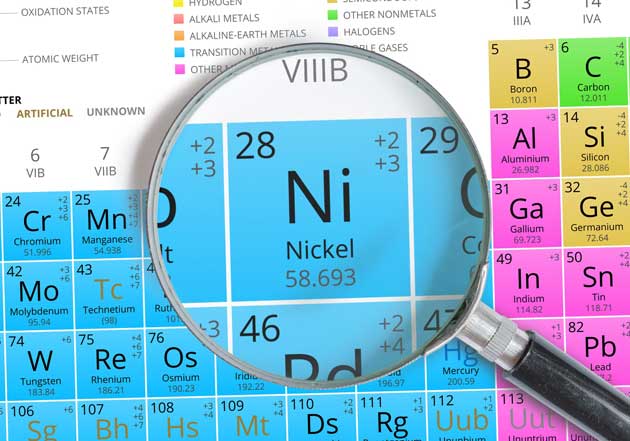
Commercial pure nickel is extensively used in industrial applications due to its inherent corrosion-resistant properties. The high-performance technically superior alloys are used across a myriad of industries, all linked by difficult operating conditions and environments. Materials need to work hard to maintain their integrity in what are highly corrosive, high-temperature and often toxic situations.
There are many Grades of alloy that have a nickel base, usually combined with a precise range of other chemical components to lend the alloy particular characteristics. However, for some applications, there is a requirement to use commercially pure nickel, two key designations of which are Nickel 200 or Nickel 201.
These materials are around 99% nickel as a minimum. The remaining 1% or less is made up of very carefully balanced values of iron, silver, manganese, copper, carbon and sulphur, in mostly trace amounts.
Caustic alkali concentration
Commercially pure nickels are used for a number of corrosion-resistant applications, which we will delve into in more depth. However, one of their more specific uses is for caustic alkali concentration processes, aka the ‘chloralkali process’.
This is a process for the electrolysis of sodium chloride solution. An essential process for most industries, this chloralkali process is used to produce chlorine and sodium hydroxide (caustic soda). It does so by using an anode to oxidise chloride into chlorine; an ion-selective membrane to control the flow of substances; and a cathode to reduce water into hydroxide and hydrogen gas.
The whole process is highly corrosive, particularly in the production of chlorine. As such, it’s imperative that the cathode element is manufactured from an easily oxidised metal, such as nickel. This is where Nickel 200/201 comes in to play to manufacture these essential components, as it is unrivalled in its resistance to these caustic alkalies.
Both chlorine and sodium hydroxide have important uses. Chlorine is probably best known for its applications in sanitation, disinfection and antisepsis – swimming pools probably first spring to mind, but it’s also used in some drinking water supplies to disinfect water. Sodium hydroxide is equally well used, with over half of all of produced sodium hydroxide going to industrial use. One of its most common uses is in the paper and pulp industry, as well as in food preparation, cleaning agents and water purification.
While both Nickel 200 and Nickel 201 can be used in caustic alkali processes, the lower-carbon Nickel 201 is especially useful. It is often used for caustic salt evaporators above 315°C – Nickel 200 could not be used at these temperatures as exposure to the extreme heat can lead to the formation of graphite due to a higher ratio of carbon (0.15% maximum as opposed to the 0.02% maximum in Nickel 201). Nickel 201 will not form graphite, even after extended exposure to high temperatures, as long as it doesn’t come into contact with any carbonaceous materials, which emit carbon-containing compounds directly into the atmosphere, for example, soot.
Electronic uses
Commercially pure nickel is commonly employed in the electronics field. It offers high electrical and thermal conductivity, compared to other nickel alloys. It also has a high Curie temperature, which is the point at which a material loses its permanent magnetic properties to be replaced with induced magnetism. It also has good magnetostrictive properties, which relates to the way that materials change shape or dimensions during magnetisation.
The world relies heavily on electronics and communications. It’s also a rapidly evolving industry where new systems and products are being introduced at a quick pace to keep up with both corporate and consumer demand. Low-alloy nickel plays an important role in the production of electrical components. This includes the manufacture of anode plates, passive cathodes, plater bars, transistor enclosures and other key electrical parts.
It’s not just the communications industry that utilises commercially pure nickel in the creation of key electrical components. Some Grades are used in optical systems, such as small lasers or telescopes. Nickel can also be used for pressure sensors in the aerospace industry, as well as oil field pressure management systems.
Nickel 200 can be produced as a fine wire, which means that it can also be used for more precise electrical applications. Over time, its uses have been expanded to include high-power radio valves. These amplifiers can increase the power of an electrical radio signal. Nickel is a material of choice for the cathode, as the use of pure metals can help to reduce frequency noise. Nickel 200 can also be used for infrared emitters, which are used in things like cameras, surveillance systems and industrial electronics.
Further uses
Nickel 200 and 201 might be best known for their uses in the electrolysis of salt solutions (brine) to extract caustic soda and chlorine, and electronics, but they do have myriad other applications.
For example, Nickel 201 can be used for pressure vessel service. It also has excellent resistance to distilled and natural waters and has extensive uses in the food-processing industry.
Nickel 200 can be used for the transportation of certain chemicals, due to its exceptionally high resistance to corrosion. It can also be used for certain aerospace components.
It’s also not uncommon to find Nickel 200 and Nickel 201 ‘dual certified’. When a material is dual certified it means that the material meets certain specification requirements of both. This processing of the nickel results in a material with the strength of Nickel 200, but the stability of compositional controls of Nickel 201.
Corrotherm supplies both Nickel 200 and Nickel 201, as well as a number of other technically superior nickel alloys. To find out more about our extensive range and speak to one of our experienced and knowledge sales managers, please get in touch today.
 Applications of Nickel 200 and 201
Applications of Nickel 200 and 201

